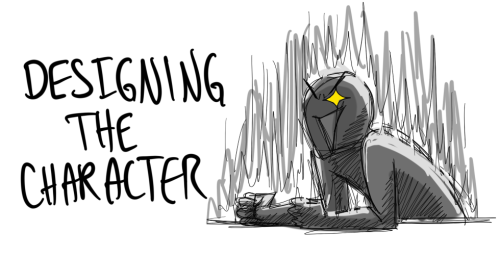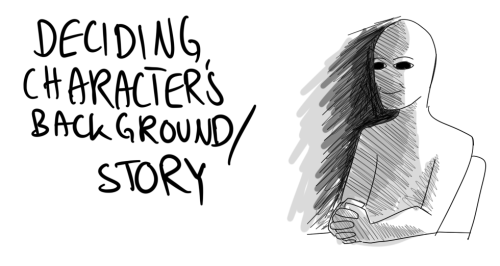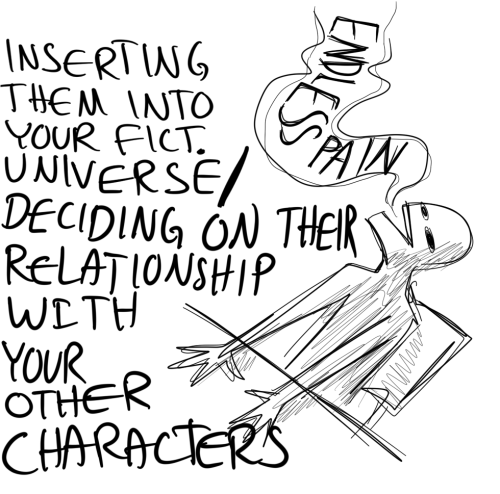Follow Your Passion: A Seamless Tumblr Journey
WritingTips - Blog Posts
For Future Reference...thank you Original Poster for creating this.
Things Real People Do in Dialogue (For Your Next Story)
Okay, let’s be real—dialogue can make or break a scene. You want your characters to sound natural, like actual humans talking, not robots reading a script. So, how do you write dialogue that feels real without it turning into a mess of awkward pauses and “ums”? Here’s a little cheat sheet of what real people actually do when they talk (and you can totally steal these for your next story):
1. People Interrupt Each Other All the Time In real conversations, nobody waits for the perfect moment to speak. We interrupt, cut each other off, and finish each other's sentences. Throw in some overlaps or interruptions in your dialogue to make it feel more dynamic and less like a rehearsed play.
2. They Don’t Always Say What They Mean Real people are masters of dodging. They’ll say one thing but mean something totally different (hello, passive-aggressive banter). Or they’ll just avoid the question entirely. Let your characters be vague, sarcastic, or just plain evasive sometimes—it makes their conversations feel more layered.
3. People Trail Off... We don’t always finish our sentences. Sometimes we just... stop talking because we assume the other person gets what we’re trying to say. Use that in your dialogue! Let a sentence trail off into nothing. It adds realism and shows the comfort (or awkwardness) between characters.
4. Repeating Words Is Normal In real life, people repeat words when they’re excited, nervous, or trying to make a point. It’s not a sign of bad writing—it’s how we talk. Let your characters get a little repetitive now and then. It adds a rhythm to their speech that feels more genuine.
5. Fillers Are Your Friends People say "um," "uh," "like," "you know," all the time. Not every character needs to sound polished or poetic. Sprinkle in some filler words where it makes sense, especially if the character is nervous or thinking on their feet.
6. Not Everyone Speaks in Complete Sentences Sometimes, people just throw out fragments instead of complete sentences, especially when emotions are high. Short, choppy dialogue can convey tension or excitement. Instead of saying “I really think we need to talk about this,” try “We need to talk. Now.”
7. Body Language Is Part of the Conversation Real people don’t just communicate with words; they use facial expressions, gestures, and body language. When your characters are talking, think about what they’re doing—are they fidgeting? Smiling? Crossing their arms? Those little actions can add a lot of subtext to the dialogue without needing extra words.
8. Awkward Silences Are Golden People don’t talk non-stop. Sometimes, they stop mid-conversation to think, or because things just got weird. Don’t be afraid to add a beat of awkward silence, a long pause, or a meaningful look between characters. It can say more than words.
9. People Talk Over Themselves When They're Nervous When we’re anxious, we tend to talk too fast, go back to rephrase what we just said, or add unnecessary details. If your character’s nervous, let them ramble a bit or correct themselves. It’s a great way to show their internal state through dialogue.
10. Inside Jokes and Shared History Real people have history. Sometimes they reference something that happened off-page, or they share an inside joke only they get. This makes your dialogue feel lived-in and shows that your characters have a life beyond the scene. Throw in a callback to something earlier, or a joke only two characters understand.
11. No One Explains Everything People leave stuff out. We assume the person we’re talking to knows what we’re talking about, so we skip over background details. Instead of having your character explain everything for the reader’s benefit, let some things go unsaid. It’ll feel more natural—and trust your reader to keep up!
12. Characters Have Different Voices Real people don’t all talk the same way. Your characters shouldn’t either! Pay attention to their unique quirks—does one character use slang? Does another speak more formally? Maybe someone’s always cutting people off while another is super polite. Give them different voices and patterns of speech so their dialogue feels authentic to them.
13. People Change the Subject In real life, conversations don’t always stay on track. People get sidetracked, jump to random topics, or avoid certain subjects altogether. If your characters are uncomfortable or trying to dodge a question, let them awkwardly change the subject or ramble to fill the space.
14. Reactions Aren’t Always Immediate People don’t always respond right away. They pause, they think, they hesitate. Sometimes they don’t know what to say, and that delay can speak volumes. Give your characters a moment to process before they respond—it’ll make the conversation feel more natural.
Important note: Please don’t use all of these tips in one dialogue at once.
This website goes into more detail about using multiple POVs.
Great tips on things to think about when writing using multiple POVs
A list of nice words we should use more to describe people
Adventurous : willing to undertake new and daring enterprises.
Affectionate : having or displaying warmth or fondness.
Ambitious : having a strong desire for success or achievement.
Amiable : diffusing warmth and friendliness.
Brave : not being afraid of danger.
Considerate : showing concern for the rights and feelings of others.
Courageous : able to face and deal with danger or fear without flinching.
Courteous : characterized by politeness and gracious good manners.
Diligent : characterized by care and perseverance in carrying out tasks.
Empathetic : showing ready comprehension of others’ states.
Exuberant : unrestrained, especially with regard to feelings.
Gregarious : temperamentally seeking and enjoying the company of others.
Humble : marked by meekness or modesty; not arrogant or prideful.
Impartial : free from undue bias or preconceived opinions.
Intuitive : obtained through instinctive knowledge.
Inventive : marked by independence and creativity in thought or action.
Kind : behaving in a caring way towards people
Passionate : having or expressing strong emotions.
Philosophical : meeting trouble with level-headed detachment.
Practical : guided by experience and observation rather than theory.
Rational : having its source in or being guided by the intellect.
Reliable : worthy of trust.
Resourceful : adroit or imaginative.
Sensible : able to feel or perceive.
Sincere : open and genuine; not deceitful.
Sympathetic : expressing compassion or friendly fellow feelings.
Witty : demonstrating striking cleverness and humor.
I am a(n):
⚪ Male
⚪ Female
🔘 Writer
Looking for
⚪ Boyfriend
⚪ Girlfriend
🔘 An incredibly specific word that I can't remember
every writing tip article and their mother: dont ever use adverbs ever!
me, shoveling more adverbs onto the page because i do what i want: just you fucking try and stop me
📚 The Art of Subtext in Writing 📚
Let’s talk about subtext. It’s one of those things you feel when you read, but maybe don’t consciously notice, and yet—it’s everywhere. It’s in the way characters talk to each other, the details they avoid, the glances that linger, and the things left unsaid. Subtext is what gives a story depth, pulling readers into the unspoken layers underneath the surface. It’s like the heartbeat of a scene, or the feeling you get when you’re reading and know there’s more to what’s happening than meets the eye.
So, why is subtext important? Because it makes stories feel real. Life isn’t always clear-cut; people don’t say exactly what they mean, emotions can be complex, and motives aren’t always laid out on the table. Subtext reflects that complexity, making your characters and situations feel richer and more relatable.
Here are a few types of subtext and how to use them effectively:
1. Romantic/Emotional Tension
This is probably the most common type of subtext, especially in romance or drama. Think of characters who clearly like each other but won’t admit it. They argue, they bicker, they avoid eye contact, but all that is subtext for “I’m secretly into you.” Use this when you want your readers to root for a connection that isn’t obvious or acknowledged yet.
2. Conflict Subtext
Not all conflict is overt—sometimes it’s in the snappy dialogue or forced politeness. A character might “agree” with something on the surface while feeling the complete opposite. This kind of subtext is powerful because it lets readers see two conflicting layers: the polite conversation happening outwardly, and the resentment or anger bubbling underneath.
3. Dramatic Irony
This is when the reader knows something the character doesn’t, creating tension or humor. Subtext here involves leaving hints in the writing that make readers feel “in on it.” For example, if a character is convinced their plan is foolproof but readers already know something’s about to go wrong, you create an undercurrent of impending doom or anticipation.
4. Thematic Subtext
Subtext isn’t just for characters; it can also layer meaning into the theme of a story. If your book’s theme is about, say, identity, you might use subtext to show how a character hides certain parts of themselves around certain people. They might be saying one thing while subconsciously revealing their discomfort or need for acceptance.
5. Cultural/Social Commentary
Sometimes the best social commentary is subtle. Rather than outright saying, “This society values material wealth over happiness,” you might show a character who’s obsessed with buying status symbols while feeling deeply unfulfilled. This approach can make readers reflect on the message more personally and deeply.
How to Use Subtext
To work subtext into your writing, trust your readers. Give them just enough so they can pick up on what’s below the surface without spelling it all out. Here’s a small exercise: write a scene between two characters who are pretending to be friendly but actually dislike each other. Notice how tone, body language, and word choice convey the tension without anyone actually saying, “I don’t like you.” It’s all about restraint.
Genres
What is a genre?
A genre is a category that your story belongs to based on form, style, or subject matter.
Action/Adventure
Your book belongs to this genre if your characters are on a quest or journey to reach a concrete goal. Take The Lighting Thief by Rick Riordan. The goal is to return the lighting bolt to Zeus before summer solstice, or there will be war.
Fantasy
Your book belongs to this genre if the world in your story has a type of magic system, or includes mythical creatures. Think of Dragons, Centaurs, Pixie dust, et cetera.
Mystery
Your book belongs to this genre if the story centers around a question(Who, What, Where, Why, and How). Think of Criminal Minds, Mondays Not Coming, Lucifer, etc.
Romance
Your book belongs to this genre if your story centers around the romantic relationship of two or more characters. Think of Five Feet Apart, To All The Boys I’ve Loved Before, Love, Simon, etc.
(Keep in mind, your story can belong to more than one genre. There are no limitations.)
If anyone has any questions, or feels as though I’ve left something out, feel free to let me know!
Reblog because I must
Could you please give me something like a list of things that need to be determined about a character, more than just age, height, gender and things like that, please i need like a list of as many as possible 💕💕💕 your blog is a miracle
I will try my best. This is a list I usually try to conform to (but I have it stored in my head, rather than as a physical list, so apologies if it doesn’t make much sense…!):
Character motivation. What are they doing? Why are they doing it?
Backstory. What happened before their debut in the story?
Greatest fear. Speaks for itself; what do they fear most?
Relationships with other characters. Who do they like? Who do they not like? Who opposes them? Who helps them? Who are they related to (by blood, or circumstance)?
Main personality traits. Positive ones, and negative ones.
Moral limits. What will they absolutely not do? What would they consider doing to meet their goal?
Attitudes/Opinions. What are the main issues in your story’s world, and what is this character’s opinion on it? How do they behave towards other characters, based on their opinions of them? Who or what do they consider to be below them? What behaviours do they choose to do or not do, which gives them a sense of importance/self-esteem (i.e. being tee-total, going to church every Sunday w/o fail, always adopting pets, rather than buying them, etc)?
Abilities. Either magical, or non-magical depending on your setting. What are they best at? What are they not so good at?
Speaking skills/conventions. How do they sound when they speak? What is their vocabulary like? How do they manage/behave in everyday conversations?
Education. According to your world’s standards, how educated is the character?
Family. How were they brought up? What was their family situation like?
Friendships. Which friendships do they value the most? How many friends do they have? How easily can they make friends?
Sexual/romantic relationships. How many relationships has the character committed to? Can they commit to relationships? How do they behave when in a relationship? How do they feel about other people’s relationships?
Work. What do they think about work? What kind of work would they like to do? What kind of work are they doing? If the character is a student, then consider their work ethic, their favourite subjects, etc.
Sense of self. What is your character’s self-image like? How do they feel about themselves? What do they think about themselves in relation to other people (i.e. how do they compare themselves to somebody else?).
Health. Speaks for itself; what is this character’s health like? In the past, in the present, and in the future?
Housekeeping. How do they live, in an everyday setting? Are they tidy, or messy? What things do they consider to be necessary to a daily routine, and what things do they consistently forget about/deem to be unimportant?
Politics. How they view society, and what should be done in a ‘civil’ society. What they think of their world’s politics. How they might ‘class’ themselves.
Religion. Their views on life, death, and creation. Their understanding of their ‘purpose’, or their beliefs in how everything came to be.
Tastes. In fashion, food, and anything else you might think of.
I hope this helps, Anon! Maybe some of our followers might reblog this and add extra things, or you might think of extra things you can add yourself. Feel free to do so, if this is the case!
- enlee
Reblog for future reference
Actually
The question I get the most is how I write characters that feel like real people.
Generally when I’m designing a human being, I deconstruct them into 7 major categories:
1. Primary Drive 2. Fear: Major and Secondary 3. Physical Desires 4. Style of self expression 5. How they express affection 6. What controls them (what they are weak for) 7. What part of them will change.
1. Primary Drive: This is generally related to the plot. What are their plot related goals? How are they pulling the plot forward? how do they make decisions? What do they think they’re doing and how do they justify doing it. 2. Fear: First, what is their deep fear? Abandonment? being consumed by power? etc. Second: tiny fears. Spiders. someone licking their neck. Small things that bother them. At least 4. 3. Physical desires. How they feel about touch. What is their perceived sexual/romantic orientation. Do their physical desires match up with their psychological desires.
4. Style of self expression: How they talk. Are they shy? Do they like to joke around and if so, how? Are they anxious or confident internally and how do they express that externally. What do words mean to them? More or less than actions? Does their socioeconomic background affect the way they present themselves socially? 5. How they express affection: Do they express affection through actions or words. Is expressing affection easy for them or not. How quickly do they open up to someone they like. Does their affection match up with their physical desires. how does the way they show their friends that they love them differ from how they show a potential love interest that they love them. is affection something they struggle with?
6. What controls them (what they are weak for): what are they almost entirely helpless against. What is something that influences them regardless of their own moral code. What– if driven to the end of the wire— would they reject sacrificing. What/who would they cut off their own finger for. What would they kill for, if pushed. What makes them want to curl up and never go outside again from pain. What makes them sink to their knees from weakness or relief. What would make them weep tears of joy regardless where they were and who they were in front of.
7. WHAT PART OF THEM WILL CHANGE: people develop over time. At least two of the above six categories will be altered by the storyline–either to an extreme or whittled down to nothing. When a person experiences trauma, their primary fear may change, or how they express affection may change, etc. By the time your book is over, they should have developed. And its important to decide which parts of them will be the ones that slowly get altered so you can work on monitoring it as you write. making it congruent with the plot instead of just a reaction to the plot.
That’s it.
But most of all, you have to treat this like you’re developing a human being. Not a “character” a living breathing person. When you talk, you use their voice. If you want them to say something and it doesn’t seem like (based on the seven characteristics above) that they would say it, what would they say instead?
If they must do something that’s forced by the plot, that they wouldn’t do based on their seven options, they can still do the thing, but how would they feel internally about doing it?
How do their seven characteristics meet/ meld with someone else’s seven and how will they change each other?
Once you can come up with all the answers to all of these questions, you begin to know your character like you’d know one of your friends. When you can place them in any AU and know how they would react.
They start to breathe.

Words related to “afraid”:
jittery
jumpy
fearful
scared
rattled
shaken
startled
panicky
anxious
worried
terrified
hesitant
alarmed
agitated
shocked
petrified
spooked
timorous
unnerved
distraught
lily-livered
frightened
distressed
concerned
intimidated
fainthearted
yellowbellied
apprehensive
disconcerted
panic-stricken





